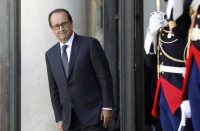ORIENTAL REVIEW opens the new historical series. We decided to name it ‘The Episodes’. We are not going to cover the world history with a comprehensive overview. It is beyond our power and competence. We want to relate to our readers few stories, which are not very known or well-forgotten by the general public and specialists. Meanwhile these stories, to our minds, have a direct reference and impact on the contemporary international situation and perhaps can be extrapolated to the future. Because as was taught by Ecclesiastes, ‘What has been will be again, what has been done will be done again; there is nothing new under the sun‘ ( Eccl. 1:9).
As it is generally accepted that in our sinful world whatever anybody speaks up about, he speaks about money, we are inaugurating ‘The Episodes’ with the glimpse into the origin of the ‘old good’ Bank of England. The current economic crisis can not be fully understood without scrutinizing the dark depths of the global financial infrastructure…
Episode 1. Bank of England.
By the end of the 17th century, England appeared on the verge of financial collapse as 50 years of nearly constant war with France had depleted the nation’s economy. Government officials entered into talks with creditors in hopes of gathering the necessary funds to continue their policies, but the interest rates offered by the creditors were very high. And so, at the behest of the government, a private bank with the power to print money came literally out of nowhere.
Such was the birth of the first ever private central bank – the Bank of England. In order to mislead the public, it bore the deceptive name, the Bank of England, but in reality was has never been a public institution. It traded its shares on the market like any other private bank from the moment of its establishment.
Investors, whose names (it is important to note) were never disclosed, were required to put in 1.25 million pounds in gold for the purchase of shares, but in reality only 750,000 pounds were paid. Despite this, the Bank of England was legally registered in 1694 and started its activities with the issuance of interest-bearing loans in amounts much greater than the amount it was supposed to have in reserves.
Today, the Bank of England has served as a model for the privately operated central banks that appear in every country of the world. Private central banks are now so powerful that they will soon control each country’s economy, which will lead to plutocracy – power in the hands of the powerful. Just imagine if we transferred the control of the military to organized crime – get the picture?
Central banks should not be in private hands! A clique of private central banks carries with it a hidden tax. Governments, which lack the political will to raise taxes, instead produce bonds and sell them to the central banks to raise money for government programs. But the bonds are bought with money that the central bank created out of thin air, and the more money is circulated, the less the money in our pockets is worth. The government receives as much money as it wants for its political goals, but the people are paying the price with inflation. The beauty of it is that hardly 10,000 people can figure out the truth hidden behind this cryptic pseudo-economical nonsense.
After the Bank of England was founded, the country experienced an influx of paper money. Prices doubled. An enormous number of loans were issued to fund any and all crazy ideas. For example, one company proposed to dry up the Red Sea in order to retrieve the gold from the supposedly sunken Egyptian army that pursued Moses as he fled leading the Israelites.
By 1698, government debt rose from 1.25 million pounds to 16 million. To pay that off, state taxes increased again and again.
In short, financial capital began to take de facto control over the state.















Very well presented. What the BofE and now US Fed Reserve (both are same) are doing are granting loans far in excess of their reserves. This is called Fractional Reserve Banking. I’ve posted a very nice article by Tim Bucholz titled “700 billion times 10”. Please visit http://mithagam.shawwebspace.ca/blog/post/fractional_reserve_banking/
Its a very interesting reading how the sharks operated. What both these banks as well as European banks are doing are printing paper money far in excess of their reserves which is leading to inflation and raising of taxes as Andre’s article has pointed out. Most imprtantly the jobs of these so called banks is to fund wars as they reap the highest profits and then become masters of the people by exerting control over governments.
This system is bound to fail, sooner or later.
Pingback: Episode 2. The US Federal Reserve. | Oriental Review
Pingback: Episode 4. Who ignited the First World War? (I) | Oriental Review
Pingback: Episode 4. Who ignited First World War? (III) | Oriental Review
Pingback: Episodes 5. Who paid for World War II? | Oriental Review
Pingback: Episode 6. Lev Trotsky, the Father of German Nazism (I) | Oriental Review
Pingback: Episode 6. Leon Trotsky, Father of German Nazism (II) | Oriental Review
Pingback: Episode 6. Leon Trotsky, Father of German Nazism (V) | Oriental Review
Pingback: Episode 6. Leon Trotsky, Father of German Nazism (IV) | Oriental Review
Pingback: Episode 7. Britain and France Planned to Assault Soviet Union in 1940 | Oriental Review
All banking systemns have an element of legerdemain but the spurious are always found out by History. If the Bank of England was built on shakey foundations then the state would most surely have tottered. Instead, the legacy of the Bank of England was a vast increase in British power culminating in the ruling of a quarter of the world. It also sparked the Industrial revolution which swept the world, even unto the backward state of Russia. Rather than being the shabby edifice you describe, it is probably the single most far-sighted structure in economic history.
Pingback: Episode 8. The Great Odd War (I) | Oriental Review
Pingback: Episode 8. The Great Odd War (II) | Oriental Review
Pingback: The Dismantiling of America into The New World Order | michaeltoups
Pingback: Episode 13. Why London presented Hitler with Vienna and Prague (I) | Oriental Review
Pingback: Episode 15. Poland Betrayed (I) | Oriental Review
David M Jordan states that ‘the spurious will be found out by history’ not realizing that orientalreview.su is one node were more truthful history is in operation while the (british) historical establishment is a deceitful tool in the hands of the type of rogue elites who used BoE for drenching Europe in blood. Industrial revolution indeed, the british had to destroy the production of high quality textile in India in order to be able to force the massproduced british textile on the people there. War technology and usury was the real nature of the farsightedness, ie mere parasitism.
Pingback: Episode 17. Britain – Adolf Hitler’s star-crossed love (I) | Oriental Review
Pingback: Episode 14. How Adolf Hitler turned to be a “defiant aggressor” (I) | WiseTheDome
East India Company was a group of British Merchants that joined together and formed a company whom the British, Dutch, French and Belgium Kings gave unbridled charter rights to Trade over vast India, China, Far East Asia and Africa. This company had 40 owners. They elected a Governor, a Deputy Governor and a board consisting of 24 Directors. The same structure was identically followed when the Bank of England was chartered. Who are these 40 share holders/owners of this company? Also East India Company is not one but 4 companies chartered in 4 different countries and all are owned by the same owners ruled by the same Governor, Deputy Governor and elected Directors. They are British East India Company, French East India Company, Belgium East India Company and Dutch East India Company. We also know that in 1858 one of these four, British East India Company was relieved from managing India and India became part of British Empire, while other East India Companies functioned until late 20th Century.
In the year 1600 East India Company was formed and given exclusive right to trade with India and South East Asia by the British Monarchy under the concept of Free Trade and Globalization. It was also given the right to civilize India. In the year 1965 the Club of Rome (top industrial houses-real owners of EICs or MNCs) divided the world in 10 economic segments and gave unbridled authority to ruthlessly exploit Segment 9 (India belongs to this segment 9), a group of mineral (diamond, gold, uranium, life saving medicinal plants, organic food and drinking water) oil and natural gas rich South East Asian nations consisting one third of the population of the world- under liberalization (liberalize domestic economy to globalize its owners) and privatization (privatize so that Free Trade can further control domestic economy via global owners) to a group of MNCs.
http://greatgameindia.com/east-india-company-part-i-noble-motives/
No mention of Jews, who funded Cromwell’s anti-monarchist faction and thereby gained ‘legal’ re-entry into Britain. Their payback was the Bank of England – those “…whose names (it is important to note) were never disclosed…”. Later expounded upon by their favorite son Mayer Amschel Rothschild:
“Let me issue and control a nation’s money and I care not who writes the laws.”
Why no mention of the Jew?
Pingback: L’infrastructure financière mondiale. Épisode 1 | Réseau International